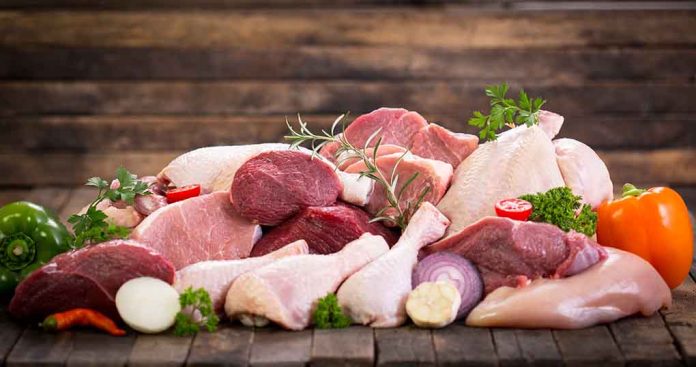
USDA commits $14.5 million to combat alarming rise in foodborne illnesses as America faces its deadliest year of food contamination, raising critical questions about the fragmented oversight system that has failed to protect consumers.
Key Takeaways
- The USDA is investing $14.5 million in state meat and poultry inspection programs amid a significant increase in foodborne illness deaths and hospitalizations in 2024.
- Agriculture Secretary Brooke Rollins emphasized this funding as part of President Trump’s commitment to maintaining a safe food supply while reducing wasteful regulations.
- The current fragmented food safety system involves multiple agencies administering over 30 different laws, prompting Sen. Tom Cotton’s SAFE FOOD Act to study consolidation.
- Small and medium-sized meat producers will benefit most from the increased funding through state inspection programs.
- The Make America Healthy Again Commission has identified pesticide exposure in children and pregnant women, adding another dimension to food safety concerns.
America’s Food Safety Crisis
The USDA’s announcement of $14.5 million in additional funding for state meat and poultry inspection programs comes at a critical time as America faces a dramatic surge in foodborne illnesses. This year has seen a disturbing increase in hospitalizations and deaths related to contaminated food, highlighting serious gaps in our nation’s food safety systems. The funding, provided as reimbursements to state programs, represents the Trump administration’s response to strengthen inspection capabilities at the local level, where they can be most effective in preventing contaminated products from reaching American dinner tables.
“President Trump is committed to ensuring Americans have access to a safe, affordable food supply. Today I exercised my authority to robustly fund state meat and poultry inspection programs to ensure states can continue to partner with USDA to deliver effective and efficient food safety inspection,” said Brooke L. Rollins, Secretary of Agriculture.
The funding increase addresses a growing crisis that threatens public health while supporting local producers. State inspection programs are particularly crucial for small and medium-sized meat processors who form the backbone of many rural economies but lack the resources to navigate complex federal inspection requirements. By strengthening these state-level programs, the USDA aims to create a more responsive safety net while maintaining the administration’s commitment to reducing bureaucratic red tape that hampers American businesses.
Streamlining a Fragmented System
Despite this positive step, America’s food safety oversight remains unnecessarily complex and inefficient. Currently, more than 15 federal agencies administer over 30 different food safety laws, creating a fragmented system that slows response times and creates dangerous gaps in coverage. This bureaucratic maze makes it difficult to address emerging threats quickly and consistently. The Government Accountability Office has repeatedly criticized this disjointed approach, calling for a cohesive national strategy that would better protect consumers while reducing taxpayer waste.
“Current food safety oversight is spread across multiple federal, state, and local agencies which decreases efficacy, creates gaps, and slows response times to potential public health risks,” said Tom Cotton Senator.
Senator Tom Cotton’s introduction of the SAFE FOOD Act represents a logical solution to this problem by studying the potential consolidation of federal food safety functions into a single agency. This approach aligns with President Trump’s broader government reform agenda aimed at eliminating wasteful duplication and making the government more accountable to the American people. Secretary Rollins has already demonstrated the benefits of this approach by cutting unnecessary regulations and ending divisive DEI initiatives at the USDA, which she reports has saved taxpayers significant money.
Supporting Local Producers
State inspection programs serve as a vital lifeline for smaller meat and poultry producers who otherwise struggle to compete with large corporate processors. The additional $14.5 million ensures these programs can continue operating effectively, preventing a situation where only the largest corporations can afford to meet federal requirements. This approach preserves consumer choice and helps maintain competitive markets that benefit both consumers and producers, particularly in rural communities where processing facilities serve as important economic anchors.
“NASDA applauds Secretary Rollins and USDA-FSIS [Food Safety and Inspection Service] for providing an additional $14.54 million to increase the reimbursement rate for this critical state cooperative agreement in this fiscal year,” said Ted McKinney CEO of the National Association of State Departments of Agriculture.
The President’s 2026 budget proposal calls on Congress to provide a permanent solution to the chronic underfunding of these essential programs. Without reliable funding, states may be forced to discontinue their inspection services, leaving many smaller producers without viable paths to market their products. This investment represents a practical approach to protecting both public health and rural economies while we work toward more comprehensive reform of the food safety system.
Broader Health Concerns
Beyond immediate food contamination issues, the Make America Healthy Again Commission has identified pesticide exposure as another significant threat to public health. Their recent report found concerning levels of pesticide residues in children and pregnant women, raising alarms about potential long-term health consequences. While recognizing that modern agriculture depends on these tools, the commission recommended balanced regulatory approaches that protect both agricultural productivity and public health.
“Without this funding, States may not have the resources to continue their own inspection programs which ensure products are safe,” stated the USDA in their announcement of the funding increase.
This additional funding for meat and poultry inspection represents just one component of what must be a comprehensive approach to ensuring America’s food supply remains the safest in the world. As food production systems become increasingly complex, our oversight mechanisms must evolve to address new challenges while supporting American producers. The Trump administration’s commitment to both public health and reducing regulatory burdens provides a blueprint for meaningful reform that serves the American people rather than expanding government bureaucracy.






